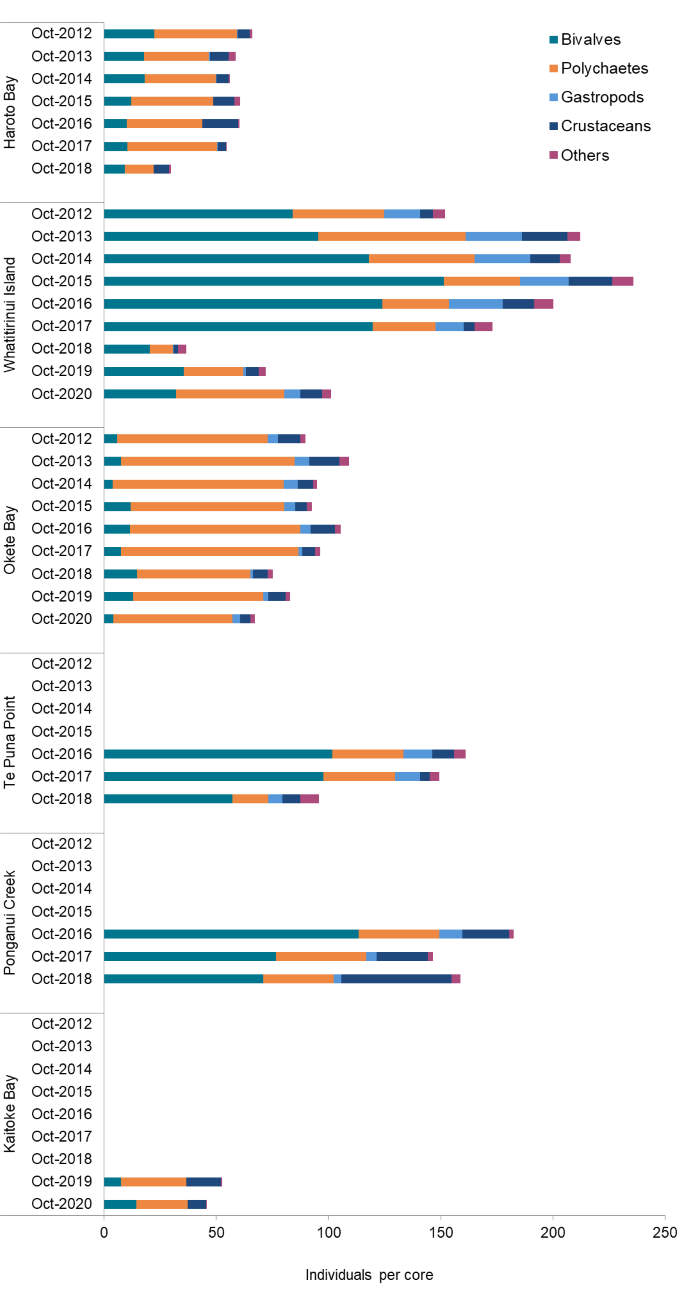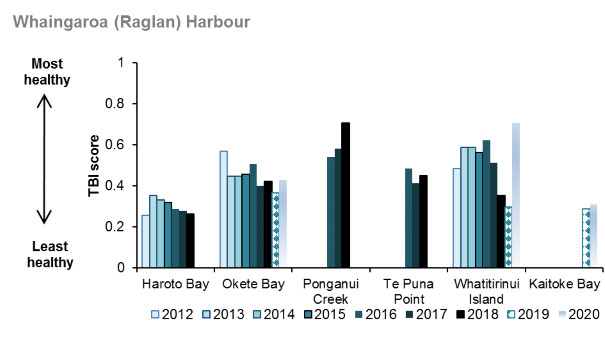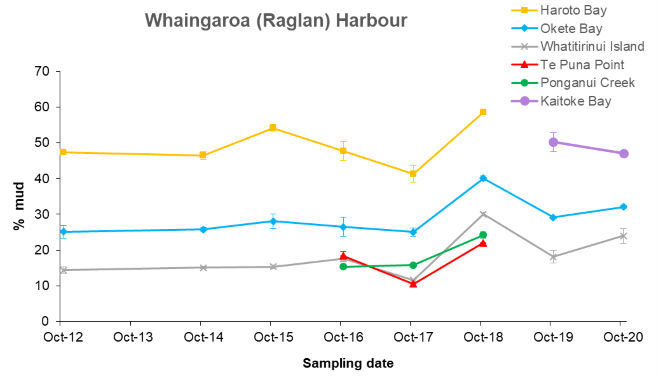Whāingaroa (Raglan) Harbour - estuary monitoring results
Sediment-dwelling organisms
In Whaingaroa (Raglan) Harbour the total number of individuals and composition of the sediment-dwelling organism community is relatively consistent at each site from 2012 to 2020. The only exceptions were low numbers in 2018 at Haroto Bay, Te Puna Point and in particular at Whatitirinui Island. Bivalves and polychaetes are the major components of the sediment-dwelling organism communities at all five Whaingaroa (Raglan) Harbour monitoring sites. Gastropods and crustaceans were relatively abundant at several monitoring locations, however their abundance varies over time.
The two northernmost monitoring sites, Whatitirinui Island and Te Puna Point have similar compositions and abundances of sediment-dwelling organism groups. Bivalves (cockles -Austrovenus stutchburyi; nut shells - Linucula hartvigiana) are most abundant, followed by polychaetes (capitellids and Prionospio aucklandica) and, to a lesser extent, gastropods (limpets - Notoacmea spp.). The composition of organisms at Ponganui Creek is similar to those at Whatitirinui Island and Te Puna Point.
At Haroto Bay and Kaitoke Bay, the abundance of sediment-dwelling organisms is typically the lowest of all monitoring sites. At these sites polychaetes (capitellids, Prionospio aucklandica and Ragworms – nereidids) are consistently more abundant than bivalves and hardly any gastropods are found. Crustaceans are relatively abundant. Our Okete Bay monitoring site, located in the middle of Whaingaroa (Raglan) Harbour, is different from all other sites with polychaetes (capitellids and Cossura consimilis) being by far the most abundant group (around 70-80% of all recorded organisms) of sediment-dwelling organisms and crustaceans typically being the second most abundant organism group.
A detailed analysis of all trends in our results as well as the relationships between sediment properties and sediment-dwelling communities are investigated in our latest trend report.

Estuarine health indicator
An estuarine health index called the Traits Based Index (TBI) is used to track the health of our estuary sites over time, and to compare the health of different estuaries. It ranges between zero and one, with one being most healthy and zero being least healthy. The TBI is calculated based on the presence of different species or organisms at a site and uses biological traits (e.g. body size, mobility, feeding behaviour). TBI scores ranged between 0.3 and 0.7 (moderately healthy) and differed between sites. Haroto Bay and Kaitoke Bay were the least healthy (with average TBI score 0.3), Whatitirinui Island and Ponganui Creek were the most healthy (with average TBI score 0.5 and 0.6 respectively).
More detailed information on the TBI can be found on the coastal biology indicator webpage.

Sediment properties
We measure sediment properties (including total organic carbon, total nitrogen, chlorophyll a, phaeophytin and grain size) at our monitoring sites and investigate if they are changing over time. Changes could indicate responses to mechanical disturbance, changes to water quality or the introduction of terrestrial sediment and contaminants. One important property we measure is grain size. If the intertidal flats are exposed to increasing sediment run-off from the catchment or other sources of fine sediment, the proportion of smaller grain sizes such as mud increases. This can create an unsuitable habitat for some sediment-dwelling animals.
The graph below shows the average (± standard error) sediment mud content (%) at each monitoring site between 2012 and 2020. The standard error is a measure of how accurate the average is. In Whaingaroa (Raglan) Harbour the highest mud content occured at Haroto Bay and Kaitoke Bay (average for both sites is 49%), compared to an average of 29% at Okete Bay and 17-18% at the three other sites (Whatitirinui Island, Te Puna Point and Ponganui Creek). Overall the mud content was relatively consistent between 2012 and 2020.
A full analysis of grain size and other sediment properties can be found in our latest trend report.



To ask for help or report a problem, contact us
Tell us how we can improve the information on this page. (optional)